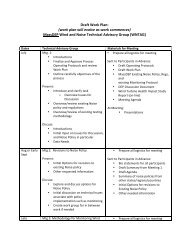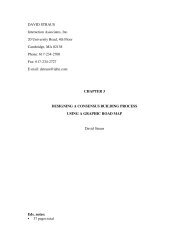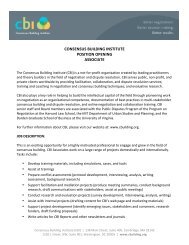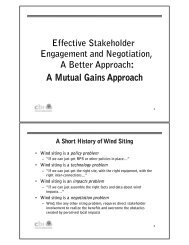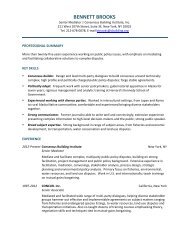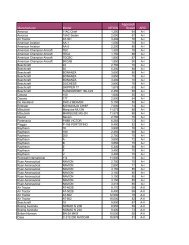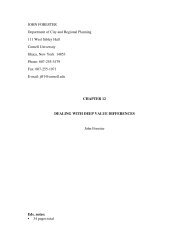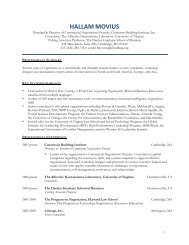Corporate and Community Engagement in the Niger Delta: Lessons ...
Corporate and Community Engagement in the Niger Delta: Lessons ...
Corporate and Community Engagement in the Niger Delta: Lessons ...
You also want an ePaper? Increase the reach of your titles
YUMPU automatically turns print PDFs into web optimized ePapers that Google loves.
<strong>Corporate</strong> <strong>and</strong> <strong>Community</strong> <strong>Engagement</strong> <strong>in</strong> <br />
<strong>the</strong> <strong>Niger</strong> <strong>Delta</strong>: <strong>Lessons</strong> Learned from <br />
Chevron <strong>Niger</strong>ia Limited’s GMOU Process <br />
Merrick Hoben, David Kovick, David Plumb, Just<strong>in</strong> Wright
<strong>Corporate</strong> <strong>and</strong> <strong>Community</strong> <strong>Engagement</strong> <strong>in</strong> <strong>the</strong> <strong>Niger</strong> <strong>Delta</strong>:<br />
<strong>Lessons</strong> Learned from Chevron <strong>Niger</strong>ia Limited’s GMOU Process<br />
By Merrick Hoben, David Kovick, David Plumb <strong>and</strong> Just<strong>in</strong> Wright 1<br />
Preface<br />
This case study seeks to draw lessons from a large-scale <strong>and</strong> ongo<strong>in</strong>g community engagement<br />
process <strong>in</strong>volv<strong>in</strong>g Chevron <strong>Niger</strong>ia Ltd. <strong>and</strong> hundreds of communities impacted by its onshore<br />
operations <strong>in</strong> <strong>the</strong> <strong>Niger</strong> <strong>Delta</strong>.<br />
Conceived of by <strong>the</strong> Consensus Build<strong>in</strong>g Institute (CBI) 2 <strong>and</strong> <strong>the</strong> <strong>Niger</strong> <strong>Delta</strong> Partnership Initiative<br />
(a foundation created by Chevron), <strong>the</strong> case was written <strong>in</strong> an effort to <strong>in</strong>crease shared<br />
underst<strong>and</strong><strong>in</strong>g of <strong>the</strong> key elements <strong>in</strong> effective corporate-community engagement, particularly <strong>in</strong><br />
complex environments such as <strong>Niger</strong>ia’s <strong>Niger</strong> <strong>Delta</strong>.<br />
CBI took <strong>the</strong> lead <strong>in</strong> draft<strong>in</strong>g <strong>the</strong> case, for which it did not receive any f<strong>in</strong>ancial compensation. CBI<br />
also received <strong>in</strong>put from Harvard University’s Kennedy School of Government’s <strong>Corporate</strong> Social<br />
Responsibility Initiative <strong>and</strong> <strong>the</strong> International F<strong>in</strong>ance Corporation regard<strong>in</strong>g its overall design <strong>and</strong><br />
content.<br />
The study draws on two Participatory Stakeholder Evaluations conducted <strong>in</strong> 2008 <strong>and</strong> 2011 that<br />
captured community, government <strong>and</strong> company views about <strong>the</strong> community engagement <strong>in</strong>itiative.<br />
It also reflects <strong>the</strong> authors’ direct experience with <strong>the</strong> engagement process, as well as <strong>in</strong>terviews with<br />
stakeholders conducted by Harvard University as part of a documentary project.<br />
CBI wishes to thank <strong>the</strong> follow<strong>in</strong>g people for <strong>the</strong>ir feedback <strong>and</strong> <strong>in</strong>put: Dennis Flemm<strong>in</strong>g, Sam<br />
Daibo <strong>and</strong> Micah Mendie – Foundation for Partnership Initiatives <strong>in</strong> <strong>the</strong> <strong>Niger</strong> <strong>Delta</strong> (PIND); Jim<br />
Dawson – Chevron Africa <strong>and</strong> Lat<strong>in</strong> America Exploration <strong>and</strong> Production (CALAEP); Professor<br />
Obafemi Ajibola - New <strong>Niger</strong>ia Foundation; Carol<strong>in</strong>e Rees – Harvard <strong>Corporate</strong> Social<br />
Responsibility Initiative; <strong>and</strong> <strong>the</strong> World Bank IFC Advisory Services group.<br />
1 Merrick Hoben is Director of CBI’s Wash<strong>in</strong>gton DC Regional Office; David Kovick is an <strong>in</strong>dependent consultant with<br />
CBI; David Plumb is a CBI Senior Associate; Just<strong>in</strong> Wright is a CBI research associate. Hoben, Kovick <strong>and</strong> Plumb coled<br />
a Participatory Stakeholder Evaluation of <strong>the</strong> GMOU process <strong>in</strong> 2008, <strong>and</strong> Kovick (with support from CBI<br />
Manag<strong>in</strong>g Director David Fairman) subsequently facilitated <strong>the</strong> renegotiation of <strong>the</strong> community agreements at <strong>the</strong><br />
<strong>in</strong>vitation of community <strong>and</strong> company representatives.<br />
2 CBI is a non-profit organization that assists communities, governments, companies, NGOs <strong>and</strong> <strong>in</strong>ternational<br />
organizations to collaborate, negotiate <strong>and</strong> resolve conflict. CBI (cbuild<strong>in</strong>g.org) is based <strong>in</strong> Cambridge, Massachusetts<br />
<strong>and</strong> Wash<strong>in</strong>gton D.C. <br />
F<strong>in</strong>al GMOU Case Study November 2012 Page 1 of 19
I. Introduction <strong>and</strong> Context<br />
This case study is about an approach to community engagement <strong>in</strong>volv<strong>in</strong>g Chevron <strong>Niger</strong>ia Ltd.<br />
(CNL) <strong>and</strong> local communities <strong>in</strong> <strong>Niger</strong>ia’s <strong>Niger</strong> <strong>Delta</strong>. In <strong>the</strong> wake of a violent <strong>in</strong>ter-ethnic crisis <strong>in</strong><br />
2003, CNL — <strong>the</strong> third largest oil producer <strong>in</strong> <strong>the</strong> country — dramatically reshaped its community<br />
engagement strategy. The new process is known as <strong>the</strong> ‘GMOU’ model, named for <strong>the</strong> formal<br />
agreements called General Memor<strong>and</strong>a of Underst<strong>and</strong><strong>in</strong>g signed between <strong>the</strong> company <strong>and</strong> clusters<br />
of communities impacted by <strong>the</strong> company’s onshore operations <strong>and</strong> government.<br />
In one of <strong>the</strong> most challeng<strong>in</strong>g contexts <strong>in</strong> <strong>the</strong> world — where relationships between communities<br />
<strong>and</strong> companies have long been characterized by substantial mistrust <strong>and</strong> antagonism — <strong>the</strong> GMOU<br />
model is succeed<strong>in</strong>g where o<strong>the</strong>r approaches have fallen short. While still far from perfect, <strong>the</strong><br />
GMOU has, at its core, helped to transform relationships between <strong>the</strong> company <strong>and</strong> surround<strong>in</strong>g<br />
stakeholder communities, lead<strong>in</strong>g to better outcomes for residents <strong>and</strong> <strong>the</strong> company.<br />
This case presents <strong>and</strong> expla<strong>in</strong>s <strong>the</strong> basics of <strong>the</strong> GMOU model, describes how stakeholders<br />
perceive it, <strong>and</strong> analyzes elements of ‘good practice’ that have emerged from it. The GMOUs were a<br />
response to <strong>the</strong> particular circumstances <strong>in</strong> <strong>the</strong> <strong>Niger</strong> <strong>Delta</strong>. We believe <strong>the</strong> lessons from this<br />
process have application to a range of situations <strong>in</strong> which communities, companies <strong>and</strong> governments<br />
must <strong>in</strong>teract.<br />
The <strong>Niger</strong> <strong>Delta</strong><br />
Oil was first discovered <strong>in</strong> 1956 <strong>in</strong> <strong>the</strong> <strong>Niger</strong> <strong>Delta</strong>, <strong>and</strong> today <strong>Niger</strong>ia is <strong>the</strong> eighth largest exporter<br />
of crude oil. ‘Black gold’ from <strong>the</strong> <strong>Delta</strong> has been <strong>the</strong> eng<strong>in</strong>e of <strong>the</strong> <strong>Niger</strong>ian national economy,<br />
account<strong>in</strong>g for as much as 95% of <strong>the</strong> country’s export earn<strong>in</strong>gs <strong>and</strong> 80% of <strong>the</strong> country’s <strong>in</strong>come.<br />
However, far from benefit<strong>in</strong>g from <strong>the</strong> oil production <strong>in</strong> <strong>the</strong> region, <strong>the</strong> people of <strong>the</strong> <strong>Niger</strong> <strong>Delta</strong><br />
are — <strong>in</strong> statistical terms — worse off today than <strong>the</strong>y were several decades ago. Today, 31 million<br />
people live <strong>in</strong> <strong>the</strong> <strong>Niger</strong> <strong>Delta</strong>, 70% of <strong>the</strong>m <strong>in</strong> extreme poverty. Life expectancy has dropped from<br />
60 years <strong>in</strong> 1970 to 40 years <strong>in</strong> 2010, among <strong>the</strong> lowest average life expectancies <strong>in</strong> <strong>the</strong> world. 70%<br />
of <strong>the</strong> <strong>Niger</strong> <strong>Delta</strong> communities lack access to safe dr<strong>in</strong>k<strong>in</strong>g water, <strong>and</strong> many more lack access to<br />
basic services such as sanitation, health care <strong>and</strong> schools.<br />
Follow<strong>in</strong>g <strong>in</strong>dependence <strong>in</strong> 1960, <strong>Niger</strong>ia was ruled by a series of military <strong>and</strong> civilian governments,<br />
who were unresponsive <strong>and</strong> unaccountable to <strong>the</strong> needs of <strong>the</strong> region. At <strong>the</strong> same time, <strong>the</strong> region<br />
suffered serious environmental degradation from oil operations that destroyed local watersheds <strong>and</strong><br />
traditional fish<strong>in</strong>g livelihoods. Grievances from <strong>Delta</strong> communities were often dealt with <strong>in</strong> military<br />
terms, result<strong>in</strong>g <strong>in</strong> severe violations of human rights.<br />
Even with <strong>the</strong> stabilization of democratic rule s<strong>in</strong>ce <strong>the</strong> 1990s, substantial governance challenges still<br />
rema<strong>in</strong>. Local, state <strong>and</strong> federal government efforts to provide socio-economic development <strong>in</strong> <strong>the</strong><br />
region have been very uneven, <strong>and</strong> have failed to meet expectations or achieve substantial<br />
improvement. Corruption rema<strong>in</strong>s a paramount challenge at every level of society.<br />
In <strong>the</strong> <strong>Delta</strong>, <strong>in</strong>justice <strong>and</strong> poverty gave rise to an armed militant movement that, until recently,<br />
targeted both government <strong>and</strong> oil <strong>in</strong>dustry facilities <strong>and</strong> operations. This led to fur<strong>the</strong>r militarization<br />
<strong>in</strong> <strong>the</strong> <strong>Delta</strong> as <strong>the</strong> government deployed a Jo<strong>in</strong>t Task Force to combat <strong>the</strong> militants <strong>and</strong> an even<br />
more unstable security situation.<br />
F<strong>in</strong>al GMOU Case Study November 2012 Page 2 of 19
The dire socio-economic situation <strong>in</strong> <strong>the</strong> <strong>Delta</strong> has only heightened <strong>the</strong> expectations that local<br />
communities have of foreign oil companies. With so little perceived government support, many<br />
communities have come to see oil companies as <strong>the</strong> only viable source for employment, economic<br />
development, <strong>and</strong> support. These expectations have far surpassed what companies can provide.<br />
As a result, relationships <strong>in</strong> <strong>the</strong> <strong>Niger</strong> <strong>Delta</strong> are characterized by a profound sense of <strong>in</strong>justice <strong>and</strong><br />
frustration. Communities sitt<strong>in</strong>g on <strong>Niger</strong>ia’s greatest resource feel passionately that <strong>the</strong>y should not<br />
live <strong>in</strong> such destitute conditions while o<strong>the</strong>rs amass untold wealth. There is substantial mistrust of<br />
leaders, of government <strong>and</strong> of <strong>in</strong>ternational oil companies, fueled by years of broken promises,<br />
exploitation <strong>and</strong> marg<strong>in</strong>alization.<br />
In 2003, <strong>the</strong> western area of <strong>the</strong> <strong>Niger</strong> <strong>Delta</strong> descended <strong>in</strong>to a bloody <strong>and</strong> destructive <strong>in</strong>ter-ethnic<br />
conflict, fueled <strong>in</strong> part by <strong>in</strong>creas<strong>in</strong>g competition over m<strong>in</strong>eral rights, <strong>and</strong> <strong>the</strong> associated benefits that<br />
communities <strong>and</strong> <strong>in</strong>dividuals hoped to reap.<br />
II. CNL’s Prior Approach to <strong>Community</strong> <strong>Engagement</strong><br />
CNL, a subsidiary of Chevron, began produc<strong>in</strong>g oil <strong>in</strong> <strong>Niger</strong>ia <strong>in</strong> 1961. CNL is <strong>in</strong> a jo<strong>in</strong>t venture<br />
with <strong>the</strong> federal government of <strong>Niger</strong>ia, which owns a majority stake <strong>in</strong> CNL’s operations. Those<br />
operations have a large footpr<strong>in</strong>t, spann<strong>in</strong>g five states <strong>and</strong> touch<strong>in</strong>g multiple ethnic groups, <strong>in</strong>clud<strong>in</strong>g<br />
over 420 separate communities <strong>and</strong> more than 850,000 people.<br />
Prior to <strong>the</strong> crisis <strong>in</strong> 2003, CNL’s approach to engagement with local communities <strong>in</strong>cluded (1)<br />
agreements with <strong>in</strong>dividual communities impacted by CNL’s operations (which provided fund<strong>in</strong>g for<br />
small-scale development projects, as well as homage payments to traditional leaders <strong>and</strong> sometimes<br />
contracts for work), <strong>and</strong> (2) larger-scale <strong>in</strong>frastructure development projects <strong>in</strong>tended to benefit <strong>the</strong><br />
region as a whole.<br />
Individual agreements with communities were problematic:<br />
• First, although <strong>in</strong>dividual agreements <strong>in</strong>cluded fund<strong>in</strong>g for local development projects, <strong>the</strong>re<br />
were few development results to show for <strong>the</strong>m. Funds often ended up enrich<strong>in</strong>g only<br />
community leaders.<br />
• Second, <strong>the</strong> lack of transparency fueled <strong>in</strong>ter-community conflict <strong>and</strong> rivalry. Each<br />
community measured itself aga<strong>in</strong>st an imag<strong>in</strong>ed benchmark of what o<strong>the</strong>r communities were<br />
rumored to be receiv<strong>in</strong>g.<br />
• Third, <strong>the</strong>se agreements were completely unmanageable from CNL’s perspective. There<br />
were over 400 separate community agreements, each <strong>in</strong>dividually negotiated. Any time<br />
operational realities required a change <strong>in</strong> <strong>the</strong> status quo (such as relocat<strong>in</strong>g an oil rig), new<br />
negotiations were required with each community.<br />
• Fourth, with so many agreements, <strong>the</strong>re were countless promises (both real <strong>and</strong> perceived)<br />
made by <strong>the</strong> company to <strong>in</strong>dividual communities, <strong>and</strong> when those promises went unfulfilled<br />
— <strong>and</strong> when <strong>the</strong>re was miscommunication <strong>and</strong> misperception about whe<strong>the</strong>r a promise had<br />
been made — mistrust cont<strong>in</strong>ued to grow.<br />
F<strong>in</strong>al GMOU Case Study November 2012 Page 3 of 19
In addition to <strong>in</strong>dividual community agreements, CNL also developed larger-scale <strong>in</strong>frastructure<br />
projects <strong>in</strong>clud<strong>in</strong>g hospitals, cl<strong>in</strong>ics, <strong>and</strong> schools. These facilities were selected, designed <strong>and</strong><br />
implemented by CNL, <strong>and</strong> seen as ‘CNL’ projects, ra<strong>the</strong>r than community projects. They generated<br />
little by way of community ownership <strong>and</strong> were often under-utilized even after <strong>the</strong>y were completed.<br />
Far from see<strong>in</strong>g <strong>the</strong>se <strong>in</strong>frastructure projects as <strong>the</strong>ir own, communities targeted <strong>the</strong>m dur<strong>in</strong>g <strong>the</strong><br />
2003 crisis.<br />
In addition to <strong>the</strong>se community engagement <strong>and</strong> community development activities, CNL <strong>in</strong>creased<br />
local hir<strong>in</strong>g <strong>and</strong> local sub-contract<strong>in</strong>g <strong>in</strong> an effort to support local economic development. They also<br />
provided scholarships for local communities. These efforts also had <strong>the</strong> un<strong>in</strong>tended effect of<br />
fur<strong>the</strong>r <strong>in</strong>flam<strong>in</strong>g tensions s<strong>in</strong>ce <strong>the</strong>re was confusion <strong>and</strong> mistrust over how <strong>the</strong>y were allocated.<br />
From a bus<strong>in</strong>ess perspective, CNL’s approach to community engagement was fail<strong>in</strong>g. It did not<br />
reduce disruptions to its operations. Many m<strong>in</strong>or community grievances turned violent <strong>and</strong> halted<br />
operations entirely. Theft <strong>and</strong> extortion, sometimes presented as community agitation, were<br />
rampant. Women <strong>and</strong> children were encouraged by community leaders to <strong>in</strong>vade CNL facilities to<br />
dem<strong>and</strong> jobs, food, <strong>and</strong> contracts, know<strong>in</strong>g that such tactics often succeeded.<br />
Dur<strong>in</strong>g <strong>the</strong> 2003 crisis, ethnic tensions boiled over <strong>in</strong>to a prolonged period of violent <strong>and</strong><br />
destructive clashes between ethnic groups, <strong>in</strong> particular two of <strong>the</strong> largest groups <strong>in</strong> <strong>the</strong> <strong>Delta</strong>, <strong>the</strong><br />
Ijaw <strong>and</strong> <strong>the</strong> Itsekiri. Villages were destroyed, <strong>and</strong> many community members were killed. CNL<br />
(along with o<strong>the</strong>r <strong>in</strong>ternational oil companies) was forced to shut down <strong>and</strong> evacuate <strong>the</strong> <strong>Niger</strong><br />
<strong>Delta</strong> until <strong>the</strong> security situation stabilized. CNL suffered more than $1 billion worth of damage to<br />
company <strong>in</strong>frastructure, as well as <strong>the</strong> destruction of social projects <strong>in</strong>tended to benefit <strong>the</strong><br />
community.<br />
As <strong>the</strong> crisis unfolded <strong>and</strong> CNL production rema<strong>in</strong>ed shut down, <strong>the</strong> company reevaluated its<br />
community engagement approach. While many of <strong>the</strong> issues that led to ethnic strife <strong>in</strong> <strong>the</strong> <strong>Niger</strong><br />
<strong>Delta</strong> were beyond CNL’s control, <strong>the</strong> exist<strong>in</strong>g model had resulted <strong>in</strong> nei<strong>the</strong>r a stable operational<br />
environment nor contributions to community development of <strong>the</strong> sort that CNL <strong>in</strong>tended, or that<br />
most community members wanted. It was clear to CNL that a new community engagement<br />
approach was needed <strong>in</strong> <strong>the</strong> <strong>Delta</strong>.<br />
Still, with MOUs outst<strong>and</strong><strong>in</strong>g with many of <strong>the</strong> communities after <strong>the</strong> crisis <strong>in</strong> 2003, CNL debated<br />
how to address <strong>the</strong>se unmet commitments. One option put forward was to h<strong>and</strong> over <strong>the</strong> money as<br />
a lump sum. However, after <strong>in</strong>ternal debate, agreement emerged with<strong>in</strong> CNL that a reliable<br />
governance model would be required <strong>in</strong> order to effectively distribute <strong>the</strong> funds for development.<br />
CNL ga<strong>the</strong>red feedback from selected community op<strong>in</strong>ion leaders <strong>and</strong> o<strong>the</strong>r key stakeholders (e.g.<br />
government) before formulat<strong>in</strong>g <strong>the</strong> new proposal of <strong>the</strong> General Memor<strong>and</strong>um of Underst<strong>and</strong><strong>in</strong>g<br />
or GMOU.<br />
III. The New Approach: The General Memor<strong>and</strong>a of Underst<strong>and</strong><strong>in</strong>g (GMOU)<br />
CNL’s Key Drivers: As CNL thought about a new approach to engag<strong>in</strong>g communities impacted by<br />
its onshore operations, it identified several key corporate objectives:<br />
• First, CNL needed to reduce <strong>and</strong>/or elim<strong>in</strong>ate disruptions to <strong>the</strong> company’s operations — a<br />
s<strong>in</strong>gle day of disruption cost <strong>the</strong> company millions of dollars;<br />
F<strong>in</strong>al GMOU Case Study November 2012 Page 4 of 19
• Second, CNL wanted to promote unity ra<strong>the</strong>r than competition among communities<br />
through its community engagement activities;<br />
• Third, CNL needed to streaml<strong>in</strong>e its community engagement approach, reduc<strong>in</strong>g 400<br />
<strong>in</strong>dividual agreements to a more manageable set of relationships;<br />
• Fourth, CNL wanted to see real development impacts result<strong>in</strong>g from its community<br />
<strong>in</strong>vestments, on <strong>the</strong> assumption that development would help address historic grievances<br />
<strong>and</strong> reduce escalat<strong>in</strong>g pressures on <strong>the</strong> company to serve as <strong>the</strong> sole source of <strong>in</strong>come,<br />
employment, <strong>and</strong> economic activity; <strong>and</strong>,<br />
• Fifth, CNL wanted to encourage o<strong>the</strong>r partners to jo<strong>in</strong> <strong>in</strong> development efforts <strong>in</strong> <strong>the</strong> <strong>Niger</strong><br />
<strong>Delta</strong>, <strong>in</strong> recognition of <strong>the</strong> fact that CNL would never be able to provide sufficient<br />
resources for economic development <strong>in</strong> <strong>the</strong> region by itself.<br />
Moreover, CNL anticipated that communities would be motivated by opportunities to have more<br />
control over development funds <strong>and</strong> activity, <strong>and</strong> well as clearer l<strong>in</strong>es of communication with <strong>the</strong><br />
company.<br />
Key Pr<strong>in</strong>ciples Underp<strong>in</strong>n<strong>in</strong>g <strong>the</strong> Model: As Chevron worked with consultants to develop<br />
details of a new approach, key pr<strong>in</strong>ciples emerged to guide <strong>the</strong> design:<br />
• Accountability: Accountability had been lack<strong>in</strong>g <strong>in</strong> previous company/community<br />
relationships: community leaders were not accountable to <strong>the</strong> communities <strong>the</strong>y were<br />
<strong>in</strong>tended to represent, <strong>and</strong> nei<strong>the</strong>r CNL nor <strong>the</strong> communities were accountable for <strong>the</strong><br />
commitments <strong>the</strong>y made to each o<strong>the</strong>r. Formal agreements were not monitored. Under <strong>the</strong><br />
new approach, community leaders were <strong>in</strong>tended to be accountable to <strong>the</strong>ir communities<br />
through clear governance structures, as well as requirements to hold annual general meet<strong>in</strong>gs<br />
<strong>and</strong> local town halls. The company <strong>and</strong> communities would be accountable to each o<strong>the</strong>r<br />
through clearly recorded agreements.<br />
• <strong>Community</strong> Ownership: Under <strong>the</strong> previous agreements, CNL often designed <strong>and</strong><br />
delivered development projects to communities, which typically had little to no <strong>in</strong>volvement<br />
<strong>in</strong> creat<strong>in</strong>g <strong>the</strong> projects. Similarly, agreements made with <strong>in</strong>dividual leaders, who were often<br />
not accountable to <strong>the</strong>ir communities, were not really “owned” by <strong>the</strong> community. The new<br />
model would shift from company-led social <strong>in</strong>vestment based on community dem<strong>and</strong>s, to<br />
community-led social <strong>in</strong>vestment (with company fund<strong>in</strong>g) based on community-identified<br />
needs.<br />
• Transparency: The previous agreements lacked transparency. Under <strong>the</strong> new model,<br />
CNL’s agreements would be negotiated with a representative group of leaders, who were<br />
required to share <strong>and</strong> discuss those agreements with <strong>the</strong>ir communities for review <strong>and</strong><br />
feedback. Local development projects funded by <strong>the</strong> RDCs were expected to be awarded<br />
through open bidd<strong>in</strong>g.<br />
• Partnership: Under <strong>the</strong> previous approach, communities were perceived by CNL as <strong>the</strong><br />
beneficiaries of <strong>the</strong>ir philanthropy. Under <strong>the</strong> new model, CNL <strong>and</strong> communities would be<br />
partners <strong>in</strong> socio-economic development projects. Each had clearly def<strong>in</strong>ed roles, <strong>and</strong> <strong>the</strong><br />
overall structure was exp<strong>and</strong>ed to <strong>in</strong>clude still o<strong>the</strong>r partners, such as NGOs <strong>and</strong> donors.<br />
• A S<strong>in</strong>gle Platform for Dialogue: CNL’s previous approach was unsuccessful <strong>in</strong> creat<strong>in</strong>g a<br />
s<strong>in</strong>gle channel for <strong>the</strong> company <strong>and</strong>/or community to raise <strong>and</strong> address concerns with each<br />
F<strong>in</strong>al GMOU Case Study November 2012 Page 5 of 19
o<strong>the</strong>r. Agreements were sometimes reached with a s<strong>in</strong>gle leader, only to have o<strong>the</strong>r<br />
members of <strong>the</strong> community make additional dem<strong>and</strong>s or take disruptive action aga<strong>in</strong>st <strong>the</strong><br />
company’s operations. The new model would make clear to all parties that <strong>the</strong> GMOU<br />
mechanism would be <strong>the</strong> platform by which nearly all issues that arose <strong>in</strong> <strong>the</strong> relationship<br />
between onshore operations <strong>and</strong> <strong>the</strong> communities would be addressed.<br />
GMOU Structures: The model that emerged from CNL’s strategy review created multi-year<br />
agreements with clusters of communities, grouped by region or ethnicity, ra<strong>the</strong>r than short-term<br />
agreements with <strong>in</strong>dividual communities. These community entities, which became known as<br />
Regional Development Councils (RDCs), did not yet exist when negotiations began. CNL<br />
encouraged <strong>the</strong>ir formation so it could negotiate with collectives <strong>and</strong> offer more substantial<br />
development fund<strong>in</strong>g. Eight RDCs were formed across <strong>the</strong> five states.<br />
CNL offered to make multi-year fund<strong>in</strong>g commitments to <strong>the</strong> RDCs to support community<br />
development activities <strong>and</strong> social <strong>in</strong>vestment. Communities were <strong>in</strong>centivized through a ‘Peace<br />
Bonus’ of additional community development funds if CNL operations rema<strong>in</strong>ed unobstructed by<br />
community agitation. These agreements reshaped <strong>the</strong> company’s relationships with communities —<br />
replac<strong>in</strong>g <strong>the</strong> 400+ <strong>in</strong>dividual community agreements, <strong>and</strong> replac<strong>in</strong>g <strong>the</strong> company’s direct control<br />
over community project identification, selection <strong>and</strong> implementation with community-led decisionmak<strong>in</strong>g.<br />
Primary responsibility for identify<strong>in</strong>g, develop<strong>in</strong>g <strong>and</strong> implement<strong>in</strong>g community development<br />
projects now rested with <strong>the</strong> RDCs, which were elected/selected by <strong>the</strong> communities. Each RDC<br />
had an oversight committee, called <strong>the</strong> <strong>Community</strong> <strong>Engagement</strong> Management Board (CEMB),<br />
consist<strong>in</strong>g of representatives from <strong>the</strong> communities, CNL, NGOs, <strong>and</strong> local <strong>and</strong> state government.<br />
The multi-stakeholder CEMB was <strong>in</strong>tended to provide oversight through a Project Review<br />
Committee (PRC), an Account/Audits Committee, <strong>and</strong> a Conflict Resolution Committee.<br />
F<strong>in</strong>al GMOU Case Study November 2012 Page 6 of 19
The GMOU <strong>in</strong> Practice: The first three-year GMOU agreements were signed <strong>in</strong> late 2005,<br />
follow<strong>in</strong>g protracted negotiations between <strong>the</strong> company <strong>and</strong> communities, some of which lasted as<br />
long as 12 months. Initially, <strong>the</strong>re was substantial mistrust on <strong>the</strong> community side about <strong>the</strong> model<br />
be<strong>in</strong>g put forward by CNL given limited <strong>in</strong>itial consultation on <strong>the</strong> new approach. <strong>Community</strong><br />
leaders said <strong>the</strong>y felt Chevron had pushed <strong>the</strong> new approach upon <strong>the</strong>m, ra<strong>the</strong>r than creat<strong>in</strong>g it with<br />
<strong>the</strong>m. <strong>Community</strong> leaders were also suspicious of Chevron oversight with<strong>in</strong> <strong>the</strong> GMOU model <strong>and</strong><br />
sought greater autonomy from <strong>the</strong> oversight structures. This <strong>in</strong>itial mistrust was only overcome with<br />
<strong>the</strong> <strong>in</strong>tervention of a local NGO as neutral facilitator. Femi Ajibola, manag<strong>in</strong>g director of a <strong>Niger</strong>iabased<br />
NGO, called <strong>the</strong> New <strong>Niger</strong>ia Foundation (NNF) 3 , used his eng<strong>in</strong>eer<strong>in</strong>g background to build<br />
trust <strong>and</strong> underst<strong>and</strong><strong>in</strong>g <strong>in</strong>side Chevron, <strong>and</strong> his deep underst<strong>and</strong><strong>in</strong>g of community issues <strong>and</strong><br />
culture <strong>in</strong> <strong>the</strong> <strong>Niger</strong> <strong>Delta</strong> to build confidence amount community leaders. Indeed, <strong>the</strong> <strong>in</strong>volvement<br />
of a credible third party buoyed <strong>the</strong> negotiations <strong>and</strong> allowed for <strong>the</strong> GMOU to move forward.<br />
Ultimately, few substantive changes were made to CNL’s <strong>in</strong>itial proposal o<strong>the</strong>r than those<br />
surround<strong>in</strong>g balance of power <strong>and</strong> oversight with<strong>in</strong> <strong>the</strong> GMOU.<br />
Dur<strong>in</strong>g <strong>the</strong>ir first three years of operation, <strong>the</strong> RDCs faced substantial challenges as <strong>the</strong>y tried to<br />
deliver tangible benefits to communities amid a lack of organizational capacity. As a first step, CNL<br />
paid for teams of local NGOs to conduct Susta<strong>in</strong>able Livelihood Assessments (SLAs) that helped<br />
communities identify <strong>the</strong>ir priorities to guide future project selection. Chevron met its commitment<br />
to transfer funds for community development. However, <strong>the</strong> <strong>in</strong>itial <strong>in</strong>ability of RDCs to implement<br />
projects caused tensions with local communities seek<strong>in</strong>g quicker results. Chevron facilitated <strong>the</strong><br />
implementation of fast-track projects to alleviate pressure, while at <strong>the</strong> same time implement<strong>in</strong>g<br />
programs to build capacity with<strong>in</strong> <strong>the</strong> RDCs. Almost two years <strong>in</strong>to <strong>the</strong> process, <strong>the</strong> first community<br />
development projects were completed.<br />
In 2008, as <strong>the</strong> first agreements were about to expire, CNL proposed a participatory stakeholder<br />
evaluation of <strong>the</strong> GMOU model <strong>in</strong> order to determ<strong>in</strong>e what was work<strong>in</strong>g <strong>and</strong> how it might be<br />
improved. Chevron had undertaken similar participatory evaluations <strong>in</strong> Angola <strong>and</strong> o<strong>the</strong>r countries.<br />
<strong>Community</strong> leaders agreed to undertake <strong>the</strong> <strong>in</strong>itiative.<br />
Partners <strong>in</strong> <strong>the</strong> GMOU process were <strong>in</strong>vited to conduct <strong>the</strong> review jo<strong>in</strong>tly (See Box 1 for more<br />
<strong>in</strong>formation). The evaluation identified strengths <strong>and</strong> weaknesses from a range of stakeholder<br />
viewpo<strong>in</strong>ts. Importantly, <strong>the</strong> evaluation also provided a credible basis for sett<strong>in</strong>g <strong>the</strong> agenda for <strong>the</strong><br />
renegotiation process, by identify<strong>in</strong>g <strong>the</strong> ways <strong>in</strong> which <strong>the</strong> GMOU model needed to be<br />
streng<strong>the</strong>ned.<br />
3 The New <strong>Niger</strong>ia Foundation served as a neutral facilitator of <strong>the</strong> process. http://www.nnfng.org/<br />
F<strong>in</strong>al GMOU Case Study November 2012 Page 7 of 19
Box 1: The GMOU <strong>in</strong> Brief<br />
The GMOU is stakeholder engagement mechanism built around formal signed agreements with clusters<br />
of communities impacted by Chevron’s on-shore operations <strong>in</strong> <strong>Niger</strong>ia. It helps to manage proactively<br />
<strong>the</strong> overall relationship between <strong>the</strong> company <strong>and</strong> impacted communities, which have a comb<strong>in</strong>ed<br />
population of about 850,000. It also is a community development tool that channels millions of dollars<br />
<strong>in</strong>to community-identified projects each year. Chevron has GMOUs with eight community clusters, each<br />
of which has formed of a Regional Development Council composed of community representatives. The<br />
councils take primary responsibility for identify<strong>in</strong>g <strong>and</strong> implement<strong>in</strong>g development projects. A<br />
management board oversees <strong>the</strong> RDC <strong>and</strong> is comprised of representatives from <strong>the</strong> government,<br />
Chevron, NGOs <strong>and</strong> <strong>the</strong> community. Chevron makes multi-year fund<strong>in</strong>g commitments to <strong>the</strong> RDCs.<br />
The approach is designed to adapt over time, based on <strong>the</strong> experience of <strong>the</strong> three-year agreements. The<br />
approach is based on <strong>the</strong> pr<strong>in</strong>ciples of partnership <strong>and</strong> shared ownership between <strong>the</strong> company <strong>and</strong> its<br />
community stakeholders.<br />
The renegotiations (See Box 2 <strong>and</strong> Box 3 for more <strong>in</strong>formation) led to a second generation of<br />
GMOU agreements that ran from 2009-2011. A second evaluation was conducted <strong>in</strong> late 2011,<br />
followed aga<strong>in</strong> by renegotiation of <strong>the</strong> GMOU agreements, which are scheduled to run through<br />
2015.<br />
Box 2: Participatory Stakeholder Evaluation<br />
As <strong>the</strong> first found of GMOU agreements approached <strong>the</strong>ir expiry <strong>and</strong> re-negotiation <strong>in</strong> 2008, CNL <strong>and</strong><br />
its community stakeholders had no shared <strong>in</strong>formation about what was work<strong>in</strong>g well with <strong>the</strong> mechanism,<br />
<strong>and</strong> what needed improvement. Ra<strong>the</strong>r than hire an external evaluator, <strong>the</strong> company embarked on a<br />
Participatory Stakeholder Evaluation <strong>in</strong> which representatives from <strong>the</strong> communities, local NGOs, <strong>the</strong><br />
government <strong>and</strong> CNL jo<strong>in</strong>tly designed <strong>and</strong> conducted an evaluation. An impartial facilitation team guided<br />
participants through <strong>the</strong> process.<br />
The evaluation began with design workshops to develop <strong>the</strong> goals of <strong>the</strong> evaluation, a data collection<br />
strategy <strong>and</strong> <strong>in</strong>terview protocol. A team of tra<strong>in</strong>ed data collectors drawn from local NGOs used <strong>the</strong><br />
strategy <strong>and</strong> protocol to conduct <strong>in</strong>terviews <strong>and</strong> focus groups <strong>in</strong> <strong>the</strong> eight RDC areas, <strong>in</strong>volv<strong>in</strong>g more<br />
than 1,000 <strong>in</strong>dividuals. The data collection team covered all five states where <strong>the</strong> GMOUs are present <strong>and</strong><br />
visited more than 20 rural <strong>Niger</strong> <strong>Delta</strong> communities, mostly by boat.<br />
<strong>Community</strong> focus groups formed <strong>the</strong> core of <strong>the</strong> data collection effort. In many communities, data<br />
collectors typically held separate focus groups with youth, women <strong>and</strong> men. O<strong>the</strong>r communities preferred<br />
to hold open town forums.<br />
When <strong>the</strong> evaluation design group reconvened to analyze <strong>in</strong>terview <strong>and</strong> focus group transcripts,<br />
community, company <strong>and</strong> government representatives were sitt<strong>in</strong>g shoulder to shoulder at tables, nam<strong>in</strong>g<br />
toge<strong>the</strong>r what <strong>the</strong> data was say<strong>in</strong>g about stakeholder perceptions. Participants remarked <strong>the</strong>y had not<br />
previously worked toge<strong>the</strong>r <strong>in</strong> this way.<br />
The process succeeded <strong>in</strong> provid<strong>in</strong>g credible, public <strong>in</strong>formation that described how community residents<br />
<strong>and</strong> o<strong>the</strong>r stakeholders were experienc<strong>in</strong>g <strong>the</strong> GMOUs. It named <strong>the</strong> core issues that needed to be<br />
addressed <strong>in</strong> <strong>the</strong> re-negotiation, <strong>and</strong>, <strong>in</strong> <strong>the</strong> process, improved stra<strong>in</strong>ed relationships, sett<strong>in</strong>g <strong>the</strong> stage for<br />
a productive <strong>in</strong>teraction dur<strong>in</strong>g <strong>the</strong> re-negotiation <strong>and</strong> beyond.<br />
A similar evaluation was conducted <strong>in</strong> 2011 as <strong>the</strong> second round of agreements came to a close. <br />
F<strong>in</strong>al GMOU Case Study November 2012 Page 8 of 19
Box 3: A Better Negotiation Approach<br />
After complet<strong>in</strong>g <strong>the</strong> Participatory Stakeholder Evaluation, company <strong>and</strong> community representatives<br />
sought impartial assistance to facilitate <strong>the</strong> re-negotiation of <strong>the</strong> GMOUs.<br />
The evaluation had surfaced frustrations about <strong>the</strong> negotiations 3 years earlier between CNL,<br />
communities <strong>and</strong> <strong>the</strong> government that created <strong>the</strong> GMOUs. Those negotiations had stretched on for<br />
months, <strong>and</strong> many community representatives said it wasn’t clear how <strong>the</strong>ir concerns were be<strong>in</strong>g<br />
<strong>in</strong>corporated <strong>in</strong>to f<strong>in</strong>al decision-mak<strong>in</strong>g. The negotiations had stra<strong>in</strong>ed relationships.<br />
For <strong>the</strong> re-negotiation, <strong>the</strong> <strong>Niger</strong>ian <strong>and</strong> U.S.-based facilitators created a 6-step process to guide <strong>the</strong><br />
parties towards new agreements. By agree<strong>in</strong>g to impartial facilitation, CNL was shar<strong>in</strong>g control over <strong>the</strong><br />
negotiation process <strong>in</strong> ways it hadn’t three years prior.<br />
The steps were:<br />
Jo<strong>in</strong>t tra<strong>in</strong><strong>in</strong>g for all parties <strong>in</strong> <strong>the</strong> Mutual Ga<strong>in</strong>s Approach to negotiation<br />
(http://cbuild<strong>in</strong>g.org/cbis-mutual-ga<strong>in</strong>s-approach-negotiation)<br />
Jo<strong>in</strong>t nam<strong>in</strong>g of <strong>the</strong> issues to be negotiated, based on <strong>the</strong> evaluation<br />
Separate, structured, <strong>and</strong> facilitated preparation by each party<br />
Jo<strong>in</strong>t sessions to share <strong>in</strong>terests <strong>and</strong> options<br />
Jo<strong>in</strong>t sessions to build packages that could create jo<strong>in</strong>t ga<strong>in</strong>s<br />
Jo<strong>in</strong>t sessions to resolve impasses <strong>and</strong> disagreements<br />
The first of <strong>the</strong> 8 GMOU re-negotiations began <strong>in</strong> late 2008, <strong>and</strong> <strong>the</strong> rema<strong>in</strong>der followed <strong>the</strong> next year.<br />
Negotiations occurred <strong>in</strong> a matter of weeks, <strong>in</strong>stead of months. The structured process, built around a<br />
Mutual Ga<strong>in</strong>s Approach, helped communities <strong>and</strong> <strong>the</strong> company identify opportunities for more valuable<br />
agreements that addressed <strong>the</strong> issues identified <strong>in</strong> <strong>the</strong> evaluation. Equally important, <strong>the</strong> negotiation<br />
process itself helped to improve relationships between <strong>the</strong> parties.<br />
A similar approach was used <strong>in</strong> late 2011 <strong>and</strong> <strong>in</strong>to 2012 dur<strong>in</strong>g <strong>the</strong> new round of GMOU re-negotiations.<br />
V. GMOU Results – 2008 <strong>and</strong> 2011 Stakeholder Perspectives<br />
The two participatory evaluations provide a w<strong>in</strong>dow <strong>in</strong>to stakeholder perceptions of <strong>the</strong> GMOUs’<br />
impact on local development <strong>and</strong> company-community relationships. 4 They po<strong>in</strong>t to aspects of <strong>the</strong><br />
approach that are work<strong>in</strong>g well, <strong>and</strong> areas that require streng<strong>the</strong>n<strong>in</strong>g. Their results are summarized<br />
below.<br />
What’s Work<strong>in</strong>g<br />
Improved relationships<br />
A large number of stakeholders said CNL’s relationship with communities has improved under <strong>the</strong><br />
GMOUs. The agreements created clearer <strong>and</strong> more predictable channels for dialogue between CNL<br />
<strong>and</strong> communities. Both parties now address issues, concerns <strong>and</strong> grievances through <strong>the</strong> RDCs,<br />
<strong>in</strong>clud<strong>in</strong>g sensitive issues such as employment <strong>and</strong> local concerns about CNL contract<strong>in</strong>g.<br />
Reduced violence<br />
This improved relationship has resulted <strong>in</strong> a dramatic reduction <strong>in</strong> violence aga<strong>in</strong>st company’s<br />
operations. Stakeholders noted a dramatic reduction <strong>in</strong> community-sponsored attacks on company<br />
4 http://cbuild<strong>in</strong>g.org/news/%5Bfield_item_type%5D/engag<strong>in</strong>g-stakeholders-nigeria%E2%80%99s-niger-delta<br />
F<strong>in</strong>al GMOU Case Study November 2012 Page 9 of 19
facilities s<strong>in</strong>ce <strong>the</strong> start of <strong>the</strong> GMOUs. Stakeholders also saw reduced tensions between<br />
communities <strong>and</strong> ethnic groups <strong>in</strong> some areas, as well as overall reductions <strong>in</strong> violence attributed <strong>in</strong><br />
part to <strong>the</strong> peace bonuses conta<strong>in</strong>ed <strong>in</strong> <strong>the</strong> GMOUs. 5 Local actors have also expressed a desire for<br />
<strong>in</strong>creased <strong>in</strong>centives for peace built <strong>in</strong>to <strong>the</strong> process <strong>in</strong> order to help fur<strong>the</strong>r reduce violence. From<br />
CNL’s perspective, <strong>the</strong> company has now shifted from more than 400 separate agreements to eight<br />
key relationships; unify<strong>in</strong>g local communities ra<strong>the</strong>r than pitt<strong>in</strong>g <strong>the</strong>m aga<strong>in</strong>st each o<strong>the</strong>r.<br />
Better development outcomes<br />
From a development perspective, many stakeholders f<strong>in</strong>d <strong>the</strong> GMOUs more effective at promot<strong>in</strong>g<br />
susta<strong>in</strong>able development, more transparent <strong>and</strong> far more conducive to community ownership of <strong>the</strong><br />
development process than previous strategies. Stakeholders from <strong>the</strong> 2008 evaluation observed that<br />
<strong>the</strong> GMOUs have help to shift CNL's engagement focus towards projects <strong>and</strong> programs that<br />
promote susta<strong>in</strong>able development versus h<strong>and</strong>outs <strong>and</strong> cash compensation. The development<br />
efforts were seen as more cost-effective <strong>and</strong> better designed to meet community needs. The<br />
<strong>in</strong>itiatives all used local labor <strong>and</strong> contractors.<br />
Greater transparency<br />
Many stakeholders said that <strong>the</strong> GMOU process was significantly more transparent than anyth<strong>in</strong>g<br />
that came before it, specifically on project approval, monitor<strong>in</strong>g, contract awards <strong>and</strong> adm<strong>in</strong>istration<br />
of accounts.<br />
However, concerns rema<strong>in</strong> that <strong>the</strong> benefit of <strong>the</strong> programs are unfair to local communities relative<br />
to <strong>the</strong> profits won by CNL. Many stakeholders th<strong>in</strong>k <strong>the</strong> overall level of employment <strong>and</strong><br />
scholarships is still <strong>in</strong>sufficient <strong>and</strong> not ‘fair’ consider<strong>in</strong>g <strong>the</strong> benefit CNL is obta<strong>in</strong><strong>in</strong>g from<br />
operat<strong>in</strong>g <strong>in</strong> <strong>the</strong> communities <strong>and</strong> that <strong>the</strong>re ought to be a greater focus on ‘human capital<br />
development’. <strong>Community</strong> members also expressed concern <strong>and</strong> frustration with a lack of clarity on<br />
<strong>the</strong> criteria used to determ<strong>in</strong>e fund<strong>in</strong>g for <strong>in</strong>dividual RDCs. These perceptions <strong>and</strong> issues around<br />
fund<strong>in</strong>g — both overall levels <strong>and</strong> criteria across RDC — cont<strong>in</strong>ue to be a major source of conflict.<br />
Indeed, community ownership of <strong>the</strong> process is closely l<strong>in</strong>ked to perceptions of transparency, as<br />
<strong>in</strong>dividuals with a greater underst<strong>and</strong><strong>in</strong>g of <strong>the</strong> process tend to enjoy a greater sense of ownership.<br />
Still o<strong>the</strong>rs noted that projects have not reflected <strong>the</strong>ir priorities, <strong>and</strong> lacked underst<strong>and</strong><strong>in</strong>g of <strong>the</strong><br />
RDC process for select<strong>in</strong>g projects. Many stakeholders said <strong>the</strong> RDCs “have <strong>the</strong> potential to be<br />
<strong>in</strong>clusive, participatory <strong>and</strong> representative of community voices.” Overall, <strong>the</strong> broad trend of<br />
stakeholder views expressed <strong>in</strong> <strong>the</strong> both <strong>the</strong> 2008 <strong>and</strong> 2011 PSE seems to be one of cautious<br />
optimism.<br />
Areas for Improvement<br />
Transparency <strong>and</strong> representation<br />
Still, many stakeholders have significant concerns about <strong>the</strong> GMOUs. Many community members<br />
do not feel that <strong>the</strong> RDCs are transparent enough or sufficiently representative of <strong>the</strong>ir <strong>in</strong>terests.<br />
While <strong>the</strong> Regional Development Councils provide a more representative platform than <strong>in</strong> previous<br />
years, many concerns persist around RDC governance. There is a history <strong>in</strong> <strong>the</strong> <strong>Niger</strong> <strong>Delta</strong> of us<strong>in</strong>g<br />
government <strong>and</strong> company funds as sources of patronage. The structures <strong>and</strong> enhanced transparency<br />
of <strong>the</strong> RDC process are aimed at address<strong>in</strong>g this issue, but some communities <strong>and</strong> RDCs are still<br />
5 This was <strong>the</strong> case at <strong>the</strong> time of <strong>the</strong> second participatory stakeholder evaluation. It is likely that some <strong>in</strong>cidences have<br />
occurred s<strong>in</strong>ce this time.<br />
F<strong>in</strong>al GMOU Case Study November 2012 Page 10 of 19
wrestl<strong>in</strong>g with this challenge, which manifests itself <strong>in</strong> concerns around how development project<br />
contracts are awarded, <strong>and</strong> how RDC representatives are chosen. The 2008 evaluation picked up<br />
<strong>the</strong>se concerns, <strong>and</strong> <strong>the</strong>y persisted <strong>in</strong> <strong>the</strong> 2011 evaluation. Notably, <strong>the</strong> <strong>in</strong>creas<strong>in</strong>g <strong>in</strong>fluence <strong>and</strong><br />
prestige of <strong>the</strong> RDCs over time has <strong>in</strong> turn led to <strong>in</strong>creased pressure by <strong>in</strong>dividuals look<strong>in</strong>g to be<br />
part of <strong>the</strong> RDC leadership, <strong>and</strong> <strong>in</strong> some <strong>in</strong>stances for personal ga<strong>in</strong>. Many stakeholders noted that<br />
<strong>the</strong> risks of corruption can <strong>and</strong> should be controlled, at least partially, through additional efforts<br />
around transparency.<br />
Balanced representation also faces ongo<strong>in</strong>g challenges. At <strong>the</strong> time of <strong>the</strong> first evaluation, women<br />
were largely excluded from RDCs, despite efforts by women leaders to have a voice. Some youth<br />
<strong>and</strong> traditional leaders expressed anger about <strong>the</strong> GMOUs, say<strong>in</strong>g it wasn’t tak<strong>in</strong>g <strong>the</strong>ir <strong>in</strong>terests <strong>in</strong>to<br />
account, while o<strong>the</strong>r youth <strong>and</strong> traditional leaders participated actively <strong>in</strong> RDCs. Accord<strong>in</strong>g to <strong>the</strong><br />
2011 evaluation, <strong>the</strong> <strong>in</strong>clusion of women had improved slightly s<strong>in</strong>ce 2008. All but one of <strong>the</strong> RDCs<br />
had at least one woman on <strong>the</strong> negotiat<strong>in</strong>g team <strong>in</strong> 2011-2012, yet women generally represented less<br />
than 20% of those teams. In addition, stakeholders said <strong>in</strong> <strong>the</strong> 2011 evaluation that <strong>the</strong>re should be<br />
greater effort to <strong>in</strong>clude elders <strong>and</strong> traditional leadership.<br />
Address<strong>in</strong>g cultural sensitivities<br />
Similarly, many traditional leaders express strong concern that CNL has transitioned away from<br />
homage payments <strong>and</strong> direct contact with <strong>the</strong>m as part of <strong>the</strong> GMOU process, <strong>in</strong> favor of lump sum<br />
fund<strong>in</strong>g to <strong>the</strong> RDCs. While it may have <strong>in</strong>creased transparency, it is perceived as culturally<br />
<strong>in</strong>sensitive by some. Tensions around this issue were exacerbated dur<strong>in</strong>g <strong>the</strong> <strong>in</strong>itial years of <strong>the</strong><br />
GMOUs because CNL’s offshore operations — which didn’t participate <strong>in</strong> <strong>the</strong> GMOU process —<br />
cont<strong>in</strong>ued to operate with <strong>the</strong> old style of community engagement. Lack of coherence between <strong>the</strong><br />
onshore <strong>and</strong> offshore bus<strong>in</strong>esses caused stra<strong>in</strong> <strong>in</strong> coastal communities undergo<strong>in</strong>g <strong>the</strong> transition to<br />
GMOUs.<br />
RDC capacity <strong>and</strong> accountability<br />
Though stakeholders perceived that <strong>the</strong> GMOUs produced more concrete development impacts<br />
than previous approaches, many expressed frustration with <strong>the</strong> pace of <strong>in</strong>itial projects, caused <strong>in</strong> part<br />
by a lack of technical capacity <strong>in</strong> <strong>the</strong> RDCs to implement. These delays were partly due to weak<br />
government partnerships, <strong>and</strong> poor underst<strong>and</strong><strong>in</strong>g of government budgets <strong>and</strong> decision-mak<strong>in</strong>g<br />
cycles that are essential <strong>in</strong>gredients to last<strong>in</strong>g collaborative decisions <strong>and</strong> commitments. As a result, a<br />
number of projects were implemented by <strong>the</strong> RDC <strong>and</strong> <strong>the</strong>n stalled due to a lack of substantive<br />
government support.<br />
The first evaluation also revealed <strong>the</strong> need to ‘professionalize’ <strong>the</strong> RDCs <strong>and</strong> stop treat<strong>in</strong>g RDC<br />
leadership positions as volunteer positions. As a result, Chevron supported large-scale efforts to<br />
build <strong>the</strong> technical capacity of RDC leadership over <strong>the</strong> follow<strong>in</strong>g three years. While valued by<br />
current leadership, some of those <strong>in</strong>terviewed <strong>in</strong> 2011 felt that <strong>the</strong> RDC leaders had <strong>in</strong> fact turned<br />
<strong>the</strong>mselves <strong>in</strong>to ‘cabals’ <strong>and</strong> were not always work<strong>in</strong>g toward <strong>the</strong> <strong>in</strong>terests of <strong>the</strong>ir communities.<br />
Some participants <strong>in</strong> that evaluation suggested that <strong>the</strong>re should be stronger systems (e.g. tenure,<br />
representation protocol, etc.) <strong>in</strong> place to ensure that <strong>the</strong> GMOU process is used to benefit <strong>the</strong><br />
community <strong>and</strong> prevents RDC leadership from absorb<strong>in</strong>g GMOU benefits before <strong>the</strong>y percolate to<br />
<strong>the</strong> communities. There is also a sense that some RDCs are not equipped to h<strong>and</strong>le conflicts<br />
generated as a result of GMOU activities.<br />
F<strong>in</strong>al GMOU Case Study November 2012 Page 11 of 19
Fund<strong>in</strong>g<br />
In addition, nearly all stakeholders <strong>in</strong> 2008 — <strong>in</strong>clud<strong>in</strong>g CNL representatives — said that GMOU<br />
fund<strong>in</strong>g was <strong>in</strong>adequate to meet <strong>the</strong> needs of <strong>Niger</strong> <strong>Delta</strong> communities. <strong>Community</strong> stakeholders<br />
said criteria for determ<strong>in</strong><strong>in</strong>g fund<strong>in</strong>g were not clear, heighten<strong>in</strong>g tensions over fund<strong>in</strong>g levels.<br />
Fund<strong>in</strong>g resurfaced as a priority issue <strong>in</strong> <strong>the</strong> 2011 evaluation, with stakeholders emphasiz<strong>in</strong>g that<br />
current levels of RDC fund<strong>in</strong>g should be <strong>in</strong>creased substantially. Many stakeholders th<strong>in</strong>k <strong>the</strong> overall<br />
level of employment <strong>and</strong> scholarships is still <strong>in</strong>sufficient <strong>and</strong> not ‘fair’ consider<strong>in</strong>g <strong>the</strong> benefit CNL<br />
is obta<strong>in</strong><strong>in</strong>g from operat<strong>in</strong>g <strong>in</strong> <strong>the</strong> communities.<br />
Coord<strong>in</strong>ation <strong>and</strong> power imbalance<br />
Coord<strong>in</strong>ation with government <strong>and</strong> o<strong>the</strong>r development actors has also fallen short of expectations.<br />
With few exceptions, RDCs have not been able to leverage fund<strong>in</strong>g from o<strong>the</strong>r sources, or<br />
coord<strong>in</strong>ate closely with government development projects. The entire process is widely perceived<br />
among donors <strong>and</strong> <strong>the</strong> government as a CNL <strong>in</strong>itiative <strong>in</strong>volv<strong>in</strong>g CNL-impacted communities,<br />
ra<strong>the</strong>r than <strong>the</strong> company-government-community partnership <strong>in</strong>itially envisioned. Similarly, several<br />
stakeholders cont<strong>in</strong>ue to perceive a power imbalance <strong>in</strong> which CNL has only slowly shared control<br />
over many aspects of <strong>the</strong> GMOU process. CNL designed <strong>the</strong> process, convened stakeholders to<br />
take part <strong>in</strong> it, <strong>and</strong> chaired many of <strong>the</strong> <strong>Community</strong> <strong>Engagement</strong> Management Boards that oversee<br />
<strong>the</strong> RDCs <strong>in</strong> <strong>the</strong> first few years of <strong>the</strong>ir development.<br />
Both <strong>the</strong> 2008 <strong>and</strong> 2011 evaluations po<strong>in</strong>t a range of views <strong>in</strong> which many stakeholders saw<br />
noticeable improvements over previous approaches, as well as significant challenges to address<br />
go<strong>in</strong>g forward. Overall, <strong>the</strong> notable successes of <strong>the</strong> GMOU process as a whole, as compared with<br />
previous efforts, have prompted <strong>the</strong> company <strong>and</strong> most community stakeholders to embrace it.<br />
VI. Analysis: Elements of Global Good Practice <strong>in</strong> <strong>the</strong> GMOU Model<br />
Although far from perfect, as noted above, <strong>the</strong> GMOU model provides an example of mean<strong>in</strong>gful<br />
community engagement. Several key strategies <strong>and</strong> practices help to expla<strong>in</strong> <strong>the</strong> predom<strong>in</strong>antly<br />
positive outcomes that have resulted from <strong>the</strong> <strong>in</strong>itiative. If cont<strong>in</strong>ued, <strong>the</strong>se practices can help<br />
address some of <strong>the</strong> challenges that still rema<strong>in</strong>:<br />
1. Creat<strong>in</strong>g a Greater Sense of Fairness <strong>in</strong> <strong>the</strong> Process: There are always substantive issues to<br />
be addressed between companies <strong>and</strong> communities, whe<strong>the</strong>r it be <strong>the</strong> amount <strong>and</strong> type of social<br />
<strong>in</strong>vestment a company makes <strong>in</strong> a community, <strong>the</strong> employment <strong>and</strong>/or contract<strong>in</strong>g<br />
opportunities that company operations might create, or compensat<strong>in</strong>g for negative impacts from<br />
extractive operations. However, equally important is <strong>the</strong> way <strong>in</strong> which both parties engage <strong>and</strong><br />
negotiate with each o<strong>the</strong>r to address <strong>the</strong>m.<br />
The GMOU process has gone fur<strong>the</strong>r than any previous effort to address <strong>in</strong>terests <strong>and</strong> concerns<br />
around how CNL <strong>and</strong> communities work through difficult substantive challenges. The creation<br />
<strong>and</strong> implementation of <strong>the</strong> GMOUs <strong>and</strong> RDCs has given community stakeholders a larger role<br />
<strong>in</strong> sett<strong>in</strong>g <strong>the</strong> terms of <strong>the</strong> conversation, <strong>and</strong> <strong>the</strong> process for <strong>in</strong>teract<strong>in</strong>g. This shift has created a<br />
greater sense of fairness <strong>in</strong> <strong>the</strong> process. It is a step towards overcom<strong>in</strong>g <strong>the</strong> long-st<strong>and</strong><strong>in</strong>g<br />
perception of a power imbalance between <strong>the</strong> company <strong>and</strong> communities, <strong>and</strong> it creates some of<br />
<strong>the</strong> key conditions for productive <strong>in</strong>teraction <strong>and</strong> problem solv<strong>in</strong>g.<br />
F<strong>in</strong>al GMOU Case Study November 2012 Page 12 of 19
Several specific strategies for creat<strong>in</strong>g greater fairness, <strong>and</strong> more equitable <strong>and</strong> transparent<br />
decision mak<strong>in</strong>g, are described <strong>in</strong> <strong>the</strong> po<strong>in</strong>ts below.<br />
2. Enabl<strong>in</strong>g <strong>the</strong> <strong>Community</strong> to Choose its Representatives: One of <strong>the</strong> most basic ways <strong>in</strong><br />
which ‘process’ matters is around <strong>the</strong> issue of representation. Often, companies choose to<br />
engage with specific <strong>in</strong>dividuals, when those <strong>in</strong>dividuals may not be <strong>the</strong> most appropriate<br />
representatives of community <strong>in</strong>terests. The company may choose <strong>in</strong>dividuals that hold more<br />
favorable views of <strong>the</strong> company, or — more often <strong>the</strong> case — exclude community leaders that<br />
<strong>the</strong>y f<strong>in</strong>d difficult or confrontational. This way of select<strong>in</strong>g community leaders <strong>and</strong> members<br />
with whom to negotiate was one of <strong>the</strong> fail<strong>in</strong>gs of CNL’s pre-2003 approach to engagement.<br />
Such approaches fail to address <strong>the</strong> full range of <strong>in</strong>terests <strong>and</strong> views held by <strong>the</strong> community, <strong>and</strong><br />
often <strong>in</strong>terfere with underly<strong>in</strong>g social <strong>and</strong> community dynamics, of which <strong>the</strong> company may not<br />
be aware. This often leads to unsusta<strong>in</strong>able agreements, <strong>and</strong> <strong>in</strong> <strong>the</strong> worst case, contributes to<br />
underly<strong>in</strong>g social conflict <strong>in</strong> a society.<br />
The GMOU model balanced CNL’s need to deal with communities collectively, with a<br />
recognition that communities needed to select <strong>the</strong>ir own representatives. The GMOU structures<br />
enabled communities to come toge<strong>the</strong>r under eight Regional Development Committees. Each<br />
RDC was a collective umbrella for diverse <strong>in</strong>terests (loosely related through ethnic <strong>and</strong> tribal<br />
structures) with<strong>in</strong> a large geographic area. With<strong>in</strong> each of <strong>the</strong> eight RDCs, <strong>the</strong> GMOU structure<br />
required communities to organize representation as <strong>the</strong>y saw fit, <strong>in</strong> terms of composition <strong>and</strong><br />
election/selection processes. Some RDCs allocate seats equally across geographic communities,<br />
while o<strong>the</strong>rs factor <strong>in</strong> population, proximity to operations, <strong>and</strong> traditional ownership of m<strong>in</strong>eral<br />
rights (even where <strong>the</strong>se may not be recognized by law). The key po<strong>in</strong>t is that this is a decision<br />
to be taken by residents <strong>and</strong> leaders with<strong>in</strong> <strong>the</strong> geographic boundaries of <strong>the</strong> RDC, not a<br />
company decision. While <strong>the</strong> stakeholder evaluations of <strong>the</strong> GMOU model po<strong>in</strong>t to cont<strong>in</strong>u<strong>in</strong>g<br />
challenges <strong>in</strong> <strong>the</strong> accountability of RDC representatives to <strong>the</strong>ir communities, RDCs recognize<br />
this as <strong>the</strong>ir own challenge to address, not one caused by CNL’s decision-mak<strong>in</strong>g about with<br />
whom it would negotiate. To be sure, <strong>the</strong> evaluations noted that many community members<br />
expressed frustration around <strong>the</strong> quality of <strong>the</strong>ir representation on <strong>the</strong> RDC, <strong>and</strong> this issue is an<br />
ongo<strong>in</strong>g challenge for <strong>the</strong> process.<br />
3. Jo<strong>in</strong>tly Sett<strong>in</strong>g <strong>the</strong> Agenda: Ano<strong>the</strong>r common pitfall for company/community engagement<br />
strategies is when companies are <strong>the</strong> only ones def<strong>in</strong><strong>in</strong>g <strong>the</strong> issues for engagement <strong>and</strong><br />
negotiation. Companies often exclude issues that are of primary importance to community<br />
stakeholders.<br />
The GMOU model created a s<strong>in</strong>gle platform for dialogue between <strong>the</strong> company <strong>and</strong> each RDC<br />
for <strong>the</strong> vast majority of issues that arise <strong>in</strong> <strong>the</strong> context of <strong>the</strong>ir relationship — <strong>in</strong>clud<strong>in</strong>g issues of<br />
social <strong>in</strong>vestment, employment, local contract<strong>in</strong>g, <strong>and</strong> management of conflict <strong>and</strong> grievances.<br />
This enabled both <strong>the</strong> RDC communities <strong>and</strong> <strong>the</strong> company to put issues on <strong>the</strong> table for<br />
dialogue <strong>and</strong> negotiation. One party may not always be able to address all issues to <strong>the</strong><br />
satisfaction of <strong>the</strong> o<strong>the</strong>r party, but <strong>the</strong> issue can be raised <strong>and</strong> addressed with<strong>in</strong> <strong>the</strong> limits of each<br />
party’s authority.<br />
One example of this from <strong>the</strong> GMOU experience is <strong>the</strong> issue of employment. A primary<br />
community <strong>in</strong>terest is to <strong>in</strong>crease employment of people from <strong>the</strong> community with<strong>in</strong> <strong>the</strong><br />
company. Legal regulations prohibit <strong>the</strong> company from creat<strong>in</strong>g any k<strong>in</strong>d of quota system for<br />
F<strong>in</strong>al GMOU Case Study November 2012 Page 13 of 19
employment. Ra<strong>the</strong>r than refus<strong>in</strong>g to address <strong>the</strong> issue, <strong>the</strong> parties have used <strong>the</strong> GMOU<br />
mechanism as a vehicle to better underst<strong>and</strong> <strong>in</strong>terests <strong>and</strong> constra<strong>in</strong>ts on both sides, <strong>and</strong> take<br />
what steps <strong>the</strong>y can improve transparency around hir<strong>in</strong>g, publiciz<strong>in</strong>g opportunities, <strong>and</strong><br />
provid<strong>in</strong>g tra<strong>in</strong><strong>in</strong>g to ensure that local applicants have <strong>the</strong> necessary skills to compete openly for<br />
available positions.<br />
4. Purs<strong>in</strong>g Mean<strong>in</strong>gful Partnership <strong>and</strong> Shared Ownership: Many company/community<br />
engagement efforts speak <strong>the</strong> language of ‘partnership’ <strong>and</strong> ‘community ownership.’ However,<br />
<strong>in</strong> reality, many of <strong>the</strong>se approaches fall short; <strong>the</strong>y cont<strong>in</strong>ue to treat communities as <strong>the</strong><br />
beneficiaries of <strong>the</strong> company’s good will. Companies, often without realiz<strong>in</strong>g it, cont<strong>in</strong>ue to<br />
dictate <strong>the</strong> terms of dialogue, drive <strong>the</strong> relationships, <strong>and</strong> impose <strong>the</strong>ir viewpo<strong>in</strong>t <strong>and</strong> <strong>in</strong>terests<br />
on communities.<br />
Under <strong>the</strong> GMOU model, CNL took significant steps to pursue mean<strong>in</strong>gful partnership <strong>and</strong><br />
shared ownership with communities. The model <strong>in</strong>vested substantial responsibility <strong>and</strong><br />
authority for social <strong>in</strong>vestment decision-mak<strong>in</strong>g <strong>in</strong> <strong>the</strong> communities <strong>the</strong>mselves, while<br />
ma<strong>in</strong>ta<strong>in</strong><strong>in</strong>g an oversight role for <strong>the</strong> company through multi-stakeholder governance structures.<br />
RDCs determ<strong>in</strong>e which projects represent <strong>the</strong> highest priorities for communities, identify<strong>in</strong>g<br />
contractors <strong>and</strong> oversee<strong>in</strong>g implementation.<br />
Even still, ‘community ownership’ is an area where <strong>the</strong> GMOU model has had to improve <strong>and</strong><br />
evolve over time, as noted <strong>in</strong> <strong>the</strong> evaluations. Leadership of <strong>the</strong> multi-stakeholder oversight<br />
boards has now transitioned from CNL representatives to NGO representatives. The GMOU<br />
evaluation process was jo<strong>in</strong>tly designed <strong>and</strong> conducted by company <strong>and</strong> community<br />
representatives <strong>and</strong> facilitated by impartial organizations, even while CNL still provided <strong>the</strong><br />
f<strong>in</strong>ancial resources. CNL <strong>in</strong>vested substantially <strong>in</strong> a credible renegotiation process, <strong>in</strong> which it<br />
‘proposed’ — ra<strong>the</strong>r than imposed — process design, time frames, venues <strong>and</strong> facilitators.<br />
5. Utiliz<strong>in</strong>g Participatory Approaches <strong>and</strong> ‘Jo<strong>in</strong>t Fact F<strong>in</strong>d<strong>in</strong>g’: Many company/community<br />
relationships are characterized by a profound sense of mistrust. In <strong>the</strong> <strong>Niger</strong> <strong>Delta</strong>, <strong>the</strong> level of<br />
mistrust is extreme, due to perceptions of past exploitation, unfulfilled commitments, <strong>and</strong> bad<br />
faith <strong>in</strong>tentions. As a result, <strong>in</strong>formation provided by one party or <strong>the</strong> o<strong>the</strong>r is immediately<br />
discounted as lack<strong>in</strong>g credibility — regardless of whe<strong>the</strong>r that <strong>in</strong>formation is objectively correct<br />
or factual. In such contexts, participatory approaches to review<strong>in</strong>g past performance, current<br />
options <strong>and</strong> constra<strong>in</strong>ts become critical, <strong>in</strong> order to build shared, credible <strong>in</strong>formation as a basis<br />
for jo<strong>in</strong>t decision-mak<strong>in</strong>g.<br />
When <strong>the</strong> first generation of GMOU agreements approached expiration, CNL proposed an<br />
evaluation of <strong>the</strong> GMOU mechanism before negotiat<strong>in</strong>g <strong>the</strong> next generation of GMOU<br />
agreements. Typically, a company might hire expert consultants to come <strong>in</strong> <strong>and</strong> evaluate <strong>the</strong><br />
model. However, RDCs <strong>and</strong> o<strong>the</strong>r stakeholders would have immediately challenged this type of<br />
company-commissioned expert evaluation as lack<strong>in</strong>g credibility. Instead, CNL proposed a<br />
participatory stakeholder evaluation of <strong>the</strong> GMOU mechanism. Ra<strong>the</strong>r than hir<strong>in</strong>g substantive<br />
experts to conduct <strong>the</strong> evaluation, neutral facilitators were brought <strong>in</strong> to help develop <strong>and</strong> run a<br />
completely transparent process <strong>in</strong> which <strong>the</strong> parties to <strong>the</strong> GMOU designed <strong>the</strong> evaluation<br />
methodology <strong>and</strong> <strong>the</strong>n jo<strong>in</strong>tly analyzed <strong>the</strong> data that emerged from <strong>in</strong>terviews <strong>and</strong> focus groups<br />
(see Box 1, page 8).<br />
F<strong>in</strong>al GMOU Case Study November 2012 Page 14 of 19
As a result, <strong>the</strong> parties jo<strong>in</strong>tly arrived at conclusions about <strong>the</strong> strengths <strong>and</strong> weaknesses of <strong>the</strong><br />
GMOU model, lay<strong>in</strong>g a credible foundation for <strong>the</strong> renegotiation process. In a more typical<br />
expert evaluation process, <strong>the</strong> parties would likely have challenged <strong>the</strong> basis of any f<strong>in</strong>d<strong>in</strong>gs from<br />
<strong>the</strong> evaluation that were unfavorable to <strong>the</strong>ir side, <strong>and</strong> dismissed any recommendations that did<br />
not favor <strong>the</strong>ir <strong>in</strong>terests. In this case, <strong>the</strong> parties accepted <strong>the</strong> jo<strong>in</strong>t evaluation f<strong>in</strong>d<strong>in</strong>gs, because<br />
<strong>the</strong>y trusted <strong>and</strong> were part of <strong>the</strong> process that produced those f<strong>in</strong>d<strong>in</strong>gs. It was no longer CNL<br />
argu<strong>in</strong>g that RDCs had to communicate more effectively with constituent communities — it was<br />
RDCs read<strong>in</strong>g this for <strong>the</strong>mselves, direct from <strong>in</strong>terview transcripts with <strong>the</strong>ir community<br />
stakeholders. It was no longer RDCs argu<strong>in</strong>g that CNL needed to <strong>in</strong>vest more f<strong>in</strong>ancial<br />
resources <strong>in</strong> <strong>the</strong> GMOU for it to succeed — it was CNL read<strong>in</strong>g this for <strong>the</strong>mselves from<br />
<strong>in</strong>terview transcripts with CNL stakeholders <strong>in</strong> <strong>the</strong> process. This shared underst<strong>and</strong><strong>in</strong>g of <strong>the</strong><br />
performance of <strong>the</strong> GMOU set <strong>the</strong> stage for jo<strong>in</strong>t problem solv<strong>in</strong>g <strong>in</strong> <strong>the</strong> negotiation phase to<br />
build upon identified strengths <strong>and</strong> address perceived weaknesses.<br />
In addition, <strong>the</strong>se k<strong>in</strong>ds of participatory approaches create opportunities for companies <strong>and</strong><br />
communities to streng<strong>the</strong>n <strong>the</strong>ir relationships by work<strong>in</strong>g ‘side-by-side’ on a process. Ra<strong>the</strong>r<br />
than sitt<strong>in</strong>g across <strong>the</strong> table from each o<strong>the</strong>r <strong>in</strong> an adversarial stance as <strong>the</strong>y often do, <strong>the</strong>y ga<strong>in</strong><br />
experience work<strong>in</strong>g toge<strong>the</strong>r collaboratively to solve problems.<br />
6. Us<strong>in</strong>g Jo<strong>in</strong>tly Selected Professional Facilitators to Build Trust: At <strong>the</strong> time <strong>the</strong> GMOU<br />
model was first proposed, community mistrust of company <strong>in</strong>tentions was so severe that<br />
negotiations over <strong>the</strong> new approach were not even possible. Communities rejected <strong>the</strong> model<br />
simply because CNL was propos<strong>in</strong>g it, <strong>and</strong> <strong>the</strong>y presumed bad faith on <strong>the</strong> part of <strong>the</strong> company.<br />
At this pivotal moment, CNL engaged <strong>the</strong> New <strong>Niger</strong>ia Foundation (NNF, noted prior) — a<br />
<strong>Niger</strong>ian NGO with experience <strong>in</strong> company/community relationships — to act as a neutral<br />
facilitator <strong>in</strong> <strong>the</strong> relationship between CNL <strong>and</strong> <strong>the</strong> communities. <strong>Community</strong> stakeholders have<br />
regularly observed that, but for <strong>the</strong> <strong>in</strong>tervention of NNF, <strong>the</strong> process would never have moved<br />
forward.<br />
Dur<strong>in</strong>g its first years of implementation, <strong>the</strong> GMOU model cont<strong>in</strong>ued to rely upon professional<br />
facilitators to broker relationships between company <strong>and</strong> community. A role for NGOs was<br />
built <strong>in</strong>to <strong>the</strong> GMOU’s multi-stakeholder structures, <strong>and</strong> over time, NGOs assumed leadership<br />
roles of <strong>the</strong> <strong>Community</strong> <strong>Engagement</strong> Management Boards (CEMB).<br />
As noted above, CNL engaged additional third parties to facilitate <strong>the</strong> participatory stakeholder<br />
evaluation <strong>and</strong> renegotiation processes. Partnerships were formed between an <strong>in</strong>ternational<br />
NGO with expertise <strong>in</strong> <strong>the</strong>se k<strong>in</strong>ds of approaches, <strong>the</strong> Consensus Build<strong>in</strong>g Institute (CBI) <strong>and</strong> a<br />
local <strong>Niger</strong>ian NGO that had greater credibility with community leaders, <strong>the</strong> Africa Centre for<br />
<strong>Corporate</strong> Responsibility (ACCR). Build<strong>in</strong>g upon <strong>the</strong> credibility established <strong>in</strong> <strong>the</strong> Participatory<br />
Stakeholder Evaluation, CBI <strong>and</strong> NNF jo<strong>in</strong>tly designed <strong>and</strong> facilitated <strong>the</strong> renegotiation process<br />
for <strong>the</strong> GMOUs (see Box 2, page 8).<br />
7. Build<strong>in</strong>g a Flexible, Adaptable Model: The GMOU was an experiment, <strong>and</strong> <strong>the</strong>re were<br />
clearly imperfections <strong>in</strong> <strong>the</strong> design <strong>and</strong> implementation of <strong>the</strong> model. After extensive<br />
negotiations to establish <strong>the</strong> structures, many communities felt that CNL had imposed <strong>the</strong><br />
model on <strong>the</strong>m. The RDCs lacked capacity at <strong>the</strong> beg<strong>in</strong>n<strong>in</strong>g of <strong>the</strong> process to participate<br />
effectively <strong>in</strong> <strong>the</strong> negotiation with CNL of <strong>the</strong> GMOU or to manage <strong>the</strong> social <strong>in</strong>vestment<br />
projects on <strong>the</strong> community development side of <strong>the</strong> model. Government entities, while happy<br />
F<strong>in</strong>al GMOU Case Study November 2012 Page 15 of 19
to endorse <strong>the</strong> model, did not make or fulfill commitments to partner <strong>in</strong> development activities<br />
to <strong>the</strong> extent envisioned. CNL still dom<strong>in</strong>ated <strong>the</strong> relationships with<strong>in</strong> <strong>the</strong> GMOU structures.<br />
However, <strong>the</strong> parties moved forward with <strong>the</strong> process, despite some reluctance from all sides,<br />
<strong>and</strong> created both <strong>the</strong> platform for dialogue <strong>and</strong> <strong>the</strong> processes to enable community development<br />
projects to proceed.<br />
The model <strong>in</strong>cluded <strong>the</strong> ability to adapt <strong>and</strong> improve as it performed. Adaptation took place<br />
through <strong>the</strong> jo<strong>in</strong>t stakeholder evaluations of <strong>the</strong> model, at <strong>the</strong> end of each of <strong>the</strong> first 3-year<br />
cycles. As weaknesses were identified through <strong>the</strong> evaluations, improv<strong>in</strong>g upon <strong>the</strong>m became a<br />
key objective of <strong>the</strong> renegotiation processes. This <strong>in</strong>vestment <strong>in</strong> <strong>the</strong> periodic review of <strong>the</strong><br />
model enables <strong>the</strong> GMOU to learn from its performance — good <strong>and</strong> bad — <strong>and</strong> adapt<br />
accord<strong>in</strong>gly. It’s also important to note that, while this model of feedback is mean<strong>in</strong>gfully<br />
improved compared to <strong>the</strong> pre-GMOU process, it may still be <strong>in</strong>adequate to fully adapt to <strong>the</strong><br />
evolv<strong>in</strong>g development needs of <strong>the</strong> communities. In fact, <strong>in</strong> <strong>the</strong> absence of even greater<br />
attention paid to adaptation <strong>and</strong> ref<strong>in</strong>ement, <strong>the</strong> GMOU process runs <strong>the</strong> risk of deterioration as<br />
it fails to identify <strong>and</strong> address key <strong>in</strong>terests with<strong>in</strong> <strong>the</strong> communities, as well as fall<strong>in</strong>g short of<br />
critical development outcomes with last<strong>in</strong>g impact. RDCs have yet to be effective at measur<strong>in</strong>g<br />
<strong>and</strong> demonstrat<strong>in</strong>g positive development impacts result<strong>in</strong>g from <strong>the</strong>ir efforts.<br />
8. Recogniz<strong>in</strong>g <strong>and</strong> Address<strong>in</strong>g Capacity Gaps: The GMOU model recognized that parties —<br />
particularly <strong>the</strong> RDCs — lacked sufficient capacity at <strong>the</strong> outset to play <strong>the</strong> roles <strong>and</strong> fulfill <strong>the</strong><br />
responsibilities envisioned for <strong>the</strong>m <strong>in</strong> <strong>the</strong> process. On <strong>the</strong> community development side, <strong>the</strong><br />
GMOU placed substantial responsibility on <strong>the</strong> newly created RDCs to be able to manage a<br />
portfolio of community development projects. However, at <strong>the</strong>ir establishment, <strong>the</strong> RDCs<br />
lacked both <strong>the</strong> basic operational functionality <strong>and</strong> <strong>the</strong> development expertise required. One of<br />
<strong>the</strong> roles of <strong>the</strong> NGOs <strong>in</strong> <strong>the</strong> GMOU structures was to provide some of this added technical<br />
capacity — to provide tra<strong>in</strong><strong>in</strong>g to <strong>the</strong> RDCs <strong>and</strong> to contribute <strong>the</strong>ir expertise <strong>in</strong> community<br />
development. When it became clear that <strong>in</strong>adequate communication with constituents<br />
threatened to underm<strong>in</strong>e <strong>the</strong> GMOU model, CNL provided additional tra<strong>in</strong><strong>in</strong>g <strong>and</strong> support to<br />
RDCs to communicate more effectively with constituents. Streng<strong>the</strong>n<strong>in</strong>g <strong>the</strong> capacity of <strong>the</strong><br />
RDCs became a shared objective for both CNL <strong>and</strong> <strong>the</strong> RDCs, <strong>and</strong> CNL established an<br />
additional fund to enable an NGO consortium to provide ongo<strong>in</strong>g tra<strong>in</strong><strong>in</strong>g <strong>and</strong> support to RDC<br />
leadership.<br />
When it came time to renegotiate <strong>the</strong> GMOU agreements, CNL recognized that <strong>the</strong> negotiation<br />
process would be more effective if both CNL <strong>and</strong> <strong>the</strong> RDCs were well prepared, <strong>and</strong> had some<br />
exposure to <strong>in</strong>terest-based (Mutual Ga<strong>in</strong>s) negotiation. RDCs agreed, <strong>and</strong> <strong>the</strong> renegotiation<br />
process began with jo<strong>in</strong>t tra<strong>in</strong><strong>in</strong>g for community <strong>and</strong> company representatives <strong>in</strong> <strong>in</strong>terest-based<br />
negotiation (See Box 3, page 9). In addition to streng<strong>the</strong>n<strong>in</strong>g relationships — by provid<strong>in</strong>g <strong>the</strong><br />
same tra<strong>in</strong><strong>in</strong>g to both parties <strong>and</strong> prompt<strong>in</strong>g <strong>in</strong>teraction dur<strong>in</strong>g that tra<strong>in</strong><strong>in</strong>g — this form of<br />
capacity-build<strong>in</strong>g had direct application to <strong>the</strong> renegotiation process <strong>the</strong>y were soon to<br />
undertake. As a result, <strong>the</strong> parties had better underst<strong>and</strong><strong>in</strong>g of how to prepare effectively for<br />
negotiations, how to create value dur<strong>in</strong>g <strong>the</strong> negotiation process, <strong>and</strong> how to create agreements<br />
that encouraged ongo<strong>in</strong>g learn<strong>in</strong>g <strong>and</strong> adaptation.<br />
9. Incremental Approaches to Build<strong>in</strong>g Trust: The GMOU was established <strong>in</strong> a context of<br />
substantial mistrust, <strong>and</strong> nobody presumed that trust could be built overnight. Ra<strong>the</strong>r, <strong>the</strong><br />
GMOU provided opportunities for both company <strong>and</strong> communities to beg<strong>in</strong> to make<br />
F<strong>in</strong>al GMOU Case Study November 2012 Page 16 of 19
commitments <strong>and</strong> deliver on those commitments, to demonstrate that <strong>the</strong>y could each be<br />
credible counterparts, <strong>and</strong> to build trust <strong>in</strong>crementally through that process. This is best done<br />
through confidence-build<strong>in</strong>g measures <strong>in</strong> lower-stakes contexts first, ra<strong>the</strong>r than immediately<br />
rush<strong>in</strong>g <strong>in</strong>to high-stakes negotiations. The expiration of <strong>the</strong> GMOUs after 3 years was one way<br />
<strong>in</strong> which <strong>the</strong> stakes were lowered for both sides. A time-bound agreement enabled both parties<br />
to move ahead, know<strong>in</strong>g that <strong>the</strong>y would have an opportunity to conventionally re-evaluate<br />
performance of <strong>the</strong> model — <strong>and</strong> how well it met <strong>the</strong>ir respective <strong>in</strong>terests — after three years.<br />
Similarly, participatory approaches <strong>and</strong> neutral parties were <strong>in</strong>troduced to <strong>the</strong> process dur<strong>in</strong>g <strong>the</strong><br />
evaluation of <strong>the</strong> GMOU, prior to <strong>the</strong> renegotiations. Had <strong>the</strong>se process elements been<br />
<strong>in</strong>troduced dur<strong>in</strong>g <strong>the</strong> renegotiations, when perceived stakes were higher, <strong>the</strong>y might not have<br />
been given <strong>the</strong> chance to succeed. The GMOU is <strong>in</strong>structive on <strong>the</strong> po<strong>in</strong>t that companies,<br />
communities <strong>and</strong> neutral third parties might be well-served by look<strong>in</strong>g for opportunities to lower<br />
<strong>the</strong> stakes of <strong>in</strong>itial engagement, when mistrust is severe.<br />
10. Rely<strong>in</strong>g on Internal Champions: Communities were not <strong>the</strong> only parties skeptical of CNL’s<br />
new approach when it first proposed <strong>the</strong> GMOU model. There were similarly many voices of<br />
concern with<strong>in</strong> <strong>the</strong> company about a partnership model that required CNL to radically change<br />
its approach, share responsibility for social <strong>in</strong>vestment with communities, <strong>and</strong> share ownership<br />
of processes for engagement between <strong>the</strong> company <strong>and</strong> communities. Support from <strong>in</strong>dividuals<br />
with<strong>in</strong> CNL was key to be able to address those concerns <strong>and</strong> ga<strong>in</strong> sufficient buy-<strong>in</strong> for <strong>the</strong><br />
project to move forward. Several of <strong>the</strong> <strong>in</strong>dividuals support<strong>in</strong>g <strong>the</strong> GMOU process had<br />
experience with similar processes that had worked <strong>in</strong> o<strong>the</strong>r regions where Chevron operated.<br />
Interest<strong>in</strong>gly, many of <strong>the</strong> key <strong>in</strong>ternal champions of <strong>the</strong> process did not have <strong>the</strong> GMOU as a<br />
core responsibility. Key to ma<strong>in</strong>ta<strong>in</strong><strong>in</strong>g support for <strong>the</strong> GMOU was <strong>the</strong> personal <strong>in</strong>terest <strong>and</strong><br />
participation of a h<strong>and</strong>-full of CNL operations managers who recognized <strong>the</strong> GMOUs’<br />
importance <strong>in</strong> enabl<strong>in</strong>g <strong>the</strong> company to operate.<br />
Chang<strong>in</strong>g course <strong>in</strong> company/community engagement requires <strong>in</strong>ternal champions who are both<br />
sufficiently senior <strong>and</strong> sufficiently capable of articulat<strong>in</strong>g a vision for a new approach <strong>and</strong><br />
build<strong>in</strong>g <strong>in</strong>ternal alignment. The GMOU model would not have been established but for <strong>the</strong>se<br />
<strong>in</strong>itial <strong>in</strong>ternal champions who were able to articulate a vision for <strong>the</strong> new approach <strong>and</strong> build<br />
alignment <strong>in</strong>ternally with<strong>in</strong> <strong>the</strong> company. Likewise, <strong>the</strong> GMOU would not have been<br />
streng<strong>the</strong>ned as it evolved but for new champions who brought with <strong>the</strong>m, at critical junctures,<br />
experience <strong>in</strong> build<strong>in</strong>g effective community partnerships <strong>and</strong> an underst<strong>and</strong><strong>in</strong>g of participatory<br />
approaches.<br />
A cont<strong>in</strong>u<strong>in</strong>g challenge for <strong>the</strong> GMOU model is that many with<strong>in</strong> <strong>the</strong> company do not have a<br />
deep underst<strong>and</strong><strong>in</strong>g of <strong>the</strong> key pr<strong>in</strong>ciples that help <strong>the</strong> GMOUs to function effectively — <strong>and</strong> at<br />
times still take decisions that could underm<strong>in</strong>e <strong>the</strong> approach. Hav<strong>in</strong>g <strong>in</strong>ternal champions who<br />
underst<strong>and</strong> <strong>the</strong> drivers that make <strong>the</strong> model work rema<strong>in</strong>s essential, particularly as those with<br />
direct experience rotate to o<strong>the</strong>r positions with<strong>in</strong> <strong>the</strong> company.<br />
F<strong>in</strong>al GMOU Case Study November 2012 Page 17 of 19
VII. Conclusions <strong>and</strong> Apply<strong>in</strong>g <strong>the</strong> <strong>Lessons</strong><br />
The GMOUs emerged as a response to <strong>the</strong> particular circumstances that CNL <strong>and</strong> its stakeholders<br />
faced <strong>in</strong> <strong>the</strong> <strong>Niger</strong> <strong>Delta</strong>. Yet <strong>the</strong> experience provides <strong>in</strong>sights for a range of situations <strong>in</strong> which<br />
communities <strong>and</strong> companies need to <strong>in</strong>teract <strong>in</strong> mean<strong>in</strong>gful ways.<br />
The ten elements of good practice described above underscore <strong>the</strong> components of effective<br />
corporate stakeholder engagement. They can be applied to a variety of scales <strong>and</strong> particular<br />
problem-sets. They speak to <strong>the</strong> importance of view<strong>in</strong>g stakeholder engagement as negotiated<br />
partnership built around <strong>the</strong> premise of shared ga<strong>in</strong>s, a commitment to fairness, <strong>and</strong> equitable<br />
participation <strong>in</strong> decision-mak<strong>in</strong>g.<br />
Companies <strong>and</strong> <strong>the</strong>ir stakeholders who seek to replicate a GMOU-type model — or simply<br />
undertake mean<strong>in</strong>gful <strong>in</strong>teraction appropriate to <strong>the</strong>ir situation — would do well to reflect on <strong>the</strong><br />
follow<strong>in</strong>g questions that codify <strong>the</strong> approach:<br />
• How can <strong>the</strong> company <strong>and</strong> its stakeholders build a more mean<strong>in</strong>gful partnership, <strong>in</strong> which<br />
communities <strong>the</strong>mselves play a central role <strong>in</strong> represent<strong>in</strong>g <strong>the</strong>ir <strong>in</strong>terests, sett<strong>in</strong>g <strong>the</strong> agenda,<br />
engag<strong>in</strong>g <strong>in</strong> <strong>in</strong>terest-based negotiation, <strong>and</strong> co-own<strong>in</strong>g <strong>the</strong> partnership, its processes <strong>and</strong> its<br />
outcomes?<br />
• How can <strong>the</strong> company <strong>and</strong> its community stakeholders use participatory approaches,<br />
supported by impartial third parties when needed, to enhance <strong>the</strong> credibility of <strong>in</strong>formation,<br />
evaluation, <strong>and</strong> <strong>the</strong> partnership build<strong>in</strong>g process?<br />
• What capacity gaps exist to support effective implementation of commitments by both <strong>the</strong><br />
company <strong>and</strong> its community partners, <strong>and</strong> how can <strong>the</strong>y be filled?<br />
• What <strong>in</strong>cremental steps can both <strong>the</strong> company <strong>and</strong> communities take to build trust?<br />
• Who can be <strong>in</strong>ternal company <strong>and</strong> community champions for a new engagement approach,<br />
<strong>and</strong> how can <strong>the</strong>y help navigate <strong>the</strong> <strong>in</strong>evitable challenges that will emerge — especially as<br />
short-term bus<strong>in</strong>ess targets <strong>and</strong> community mistrust push aga<strong>in</strong>st longer-term partnership<br />
objectives?<br />
In conclusion, <strong>the</strong> evolution of partnership between CNL <strong>and</strong> <strong>the</strong> communities affected by its<br />
operations is far from complete. Yet, <strong>the</strong> lessons of this experience to date — as well as core<br />
questions <strong>the</strong> GMOU experience poses — are no doubt worth considerable attention globally, as we<br />
collectively cont<strong>in</strong>ue to seek a transformation of corporate-community engagement <strong>in</strong>to real <strong>and</strong><br />
last<strong>in</strong>g partnership.<br />
F<strong>in</strong>al GMOU Case Study November 2012 Page 18 of 19





